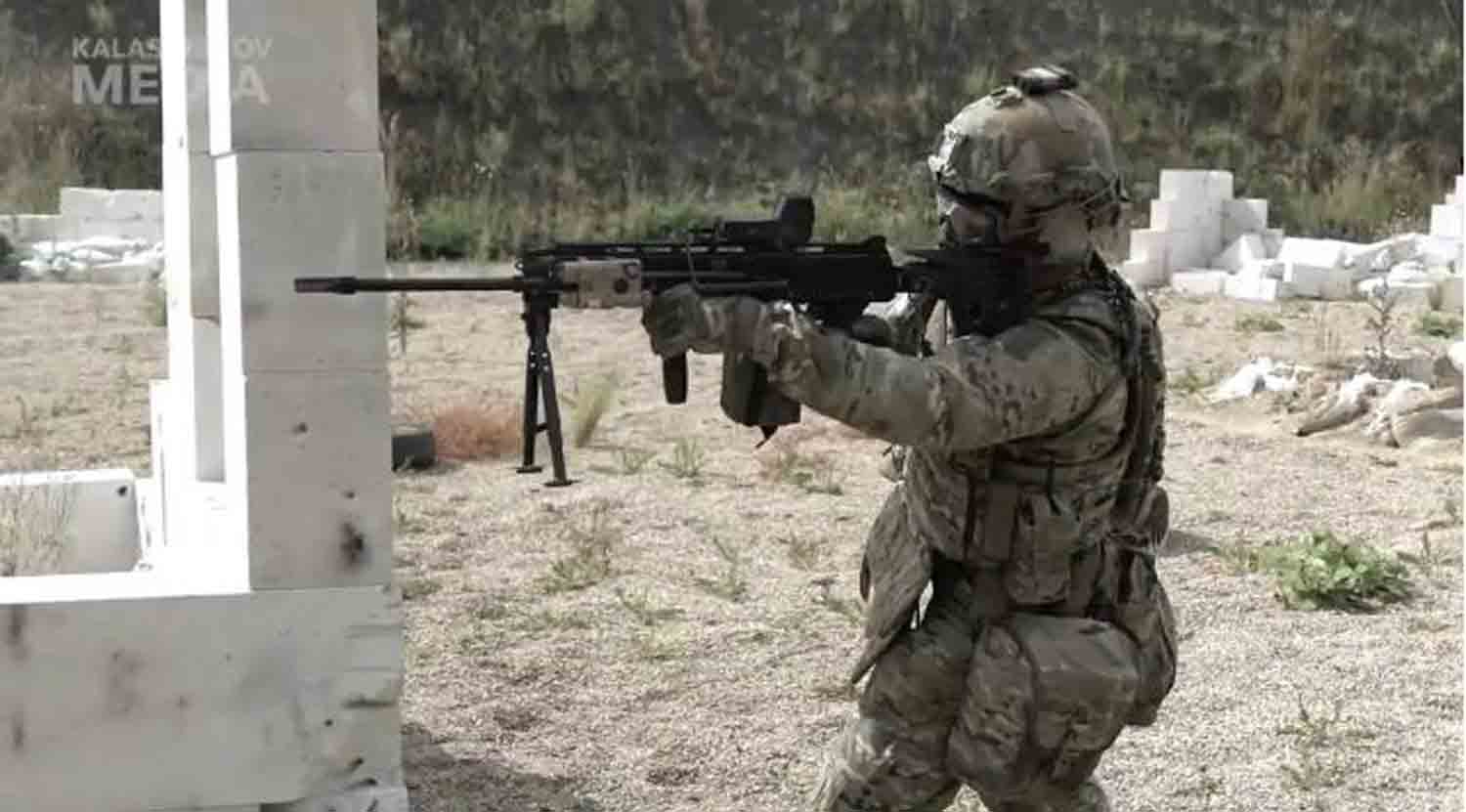In the extensive conflict area that Russia refers to as its “special military operation” in Ukraine, a new weapon has quietly emerged on the battlefield. The RPL-20, a lightweight machine gun chambered in 5.45mm, is now actively deployed, as confirmed by Sergey Urzhumtsev, the chief designer at Kalashnikov Concern, Russia’s leading firearms manufacturer.
In a statement to the state-owned news agency TASS, Urzhumtsev acknowledged the weapon’s presence, remarking, “I can say that there are machine guns in the area where the special military operation is being conducted.” This understated yet significant announcement highlights Russia’s ongoing efforts to enhance its infantry capabilities amid a protracted conflict.
The RPL-20 has made a rapid yet careful journey to the front lines. Its development concluded in September 2024, shortly after its official introduction at the end of August. By late September, Kalashnikov Concern declared that the weapon—a belt-fed design aimed at neutralizing enemy personnel and light equipment—was fully operational.
What distinguishes the RPL-20 is its versatility, featuring modern capabilities that enable it to accommodate a variety of accessories and function reliably in the unpredictable conditions of combat. Its deployment in Ukraine reflects Russia’s commitment to refining its military arsenal, even as the conflict enters its third year.
This weapon represents more than just another addition to military hardware; it signifies a strategic evolution. The RPL-20 was officially presented at the 5th International Defense Industry Exhibition, ADEX 2024, which took place in Baku from September 24 to 26.
Amid the activity of global arms dealers and military representatives, it attracted the attention of the Russian National Guard, a unit known for monitoring Kalashnikov’s latest innovations. The gun’s adaptability and advanced design generated interest, suggesting its potential use beyond the immediate battlefield.
For Russia, a country historically associated with robust and dependable weaponry, the RPL-20 signifies a blend of heritage and innovation.
The RPL-20 is a testament to contemporary engineering, specifically designed for the complexities of infantry combat. Weighing between 5.2 and 5.5 kilograms—similar to a fully loaded backpack—it strikes a balance between mobility for soldiers and the durability needed for sustained fire.
It utilizes the widely used 5.45x39mm cartridge, the same ammunition found in the AK-12 assault rifle, which ensures compatibility with current Russian logistics. In contrast to earlier magazine-fed models, the RPL-20 employs a belt-fed mechanism, utilizing non-disintegrating steel belts stored in semi-rigid boxes that can accommodate either 100 or 200 rounds.
This design enhances its ability to provide suppressive fire, a vital asset in the trench-heavy, urban conflicts that characterize much of the ongoing fighting in Ukraine.
What sets the RPL-20 apart is its versatility across various combat situations. It is available in two configurations: a long-barreled variant with a 590mm barrel for engaging targets at distances up to a kilometer, and a shorter 415mm version tailored for close-quarters combat, akin to the effective range of the AK-74.
The long barrel version weighs approximately 5.5 kilograms when unloaded, while the shorter variant is designed to be lighter for enhanced maneuverability. Both models utilize a gas-operated mechanism featuring a long-stroke piston situated above the barrel, a signature element of Kalashnikov’s time-tested design approach, and are equipped with a rotating bolt that ensures a secure lock for each firing.
Designed to fire from an open bolt, this weapon is exclusively for automatic fire, delivering rounds at a rapid rate of around 600 per minute during sustained bursts.
The ergonomics of the firearm demonstrate a careful integration of aesthetics and practicality. It includes a folding telescopic stock with an adjustable cheek rest and shoulder support, providing shooters with comfort and accuracy in various shooting positions.
The receiver is equipped with an extensive Picatinny rail on the top, allowing for the attachment of optical sights, night vision devices, or laser designators, while the lower rail is suitable for mounting bipods or foregrips. Although the barrel is not designed for quick changes in the conventional sense, it can be replaced during disassembly, catering to the needs of extended combat scenarios.
Kalashnikov has also included a specially engineered suppressor that can endure prolonged firing without performance degradation, a feature not commonly found in standard-issue silencers. With a service life rated for 20,000 rounds, the RPL-20 is constructed to withstand the rigors of warfare.
To appreciate the RPL-20’s role within Russia’s military inventory, it is essential to consider the machine guns it is intended to augment or replace. The RPK-74, a magazine-fed light machine gun that has been in service since the 1970s, has historically been a fundamental asset for Soviet and Russian infantry units.
Chambered for the 5.45x39mm cartridge, this weapon utilizes 45-round magazines or, in certain instances, 75-round drums, providing a lighter alternative to belt-fed systems, albeit with a compromise in sustained fire capability. Weighing approximately 4.7 kilograms, it is a robust and dependable option; however, its limitations have become evident in contemporary conflicts where the need for high volume fire often overshadows precision.
The RPK-16, introduced in 2016, sought to rectify these issues by incorporating a 96-round drum and interchangeable barrels. Unfortunately, it faced challenges during testing due to overheating and reliability concerns, leading Kalashnikov to shift focus towards the belt-fed RPL-20.
On the heavier side, the PKM is a 7.62x54mmR general-purpose machine gun that has served as a cornerstone for Russian forces since the 1960s. Weighing in at 7.5 kilograms without its 100- or 250-round belts, it is designed for suppressive fire at the company level rather than for squad-level mobility.
Its impressive range and firepower—effective up to 1,500 meters—make it a powerful asset, but its weight and caliber distinguish it from the lighter, intermediate-cartridge role that the RPL-20 occupies. The RPD, a belt-fed predecessor from the 1940s chambered in 7.62x39mm, provides a historical context for the RPL-20, although it was retired by the 1960s in favor of the RPK series.
Consequently, the RPL-20 serves as a bridge, merging the portability of the RPK with the firepower of the PKM, designed to meet the dynamic and high-intensity requirements of modern warfare.
Kalashnikov has played a crucial role in supporting Russia’s military operations in Ukraine over the last three years. Following the escalation of the conflict in February 2022, the company significantly increased its production to satisfy the growing demands of the Ministry of Defense.
The AK-12, which became the standard rifle for the Russian Ground Forces in 2018, has experienced substantial deliveries, with 2023 and 2024 alone accounting for 65% of the annual state order. This rifle, weighing 3.7 kilograms and utilizing 5.45x39mm ammunition from 30-round magazines, has been refined based on combat experiences from the front lines in Ukraine.
In addition to the AK-12, the AK-15 [7.62x39mm] and AK-19 [5.56x45mm NATO] have been adopted by specialized units, demonstrating Kalashnikov’s capacity to expand its product range.
Kalashnikov has also provided a variety of other military equipment. The PKP Pecheneg, an upgraded version of the PKM, has been observed in Ukraine, delivering 7.62x54mmR rounds capable of penetrating fortifications, and featuring a quick-change barrel for extended firing capabilities. Weighing 8.2 kilograms, it is favored by troops requiring heavy fire support.
Additionally, the company introduced the GP-46, a 40x46mm underbarrel grenade launcher revealed in August 2024, which can be used with AK rifles or independently with a detachable stock—ideal for targeting trenches or light vehicles.
The production of drones, optics, and body armor has surged from Kalashnikov’s facilities, with increases in output announced in 2023 to meet the ongoing demand for military equipment. By mid-2024, the RPL-20 was added to their offerings, with its initial batch delivered for operational testing, underscoring Kalashnikov’s unwavering production pace.
This surge of innovation occurs amidst significant economic challenges. Western sanctions, initially enacted after Russia’s annexation of Crimea in 2014 and intensified following the 2022 invasion of Ukraine, were designed to undermine Moscow’s military capabilities. These sanctions specifically targeted Russia’s defense industry, including the Kalashnikov Concern, by limiting access to foreign technology, capital, and markets.
The European Union, the United States, and their allies implemented asset freezes, prohibited the export of dual-use goods, and restricted financial transactions, aiming to weaken Russia’s military-industrial complex. By 2023, the ruble had significantly depreciated, and inflation had surged; however, Kalashnikov and the wider Russian arms sector continued to operate effectively.
How was this achieved? Through adaptation and resilience. Kalashnikov utilized domestic resources and increased in-house research and development to reduce dependence on imports. The RPL-20, developed without direct military funding and driven by Kalashnikov’s initiative following the RPK-16 trials, serves as a prime example of this self-reliance.
Russia’s shift towards trading with friendly nations such as China, India, and Iran allowed it to circumvent sanctions, while a war economy—bolstered by state contracts—pumped billions into defense. At ADEX 2024, Kalashnikov showcased the RPL-20 alongside plans for 7.62x39mm and 5.56x45mm variants, indicating aspirations that extend beyond Russia’s borders, targeting export markets despite Western pressures.
While sanctions have impeded progress, they have not completely stifled it; Russia’s arms manufacturers, led by Kalashnikov, have demonstrated their ability to innovate under challenging circumstances—both literally and figuratively—ensuring that the RPL-20 and similar products make it to the battlefield against the odds.
Discover more from Defence Talks | Defense News Hub, Military Updates, Security Insights
Subscribe to get the latest posts sent to your email.





